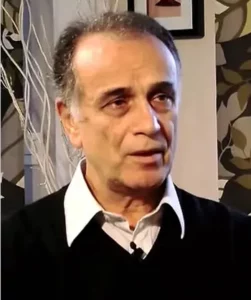
On February 8, 1971 a group of armed leftists attacked a gendarmerie post at Siahkal on the Caspian Sea in an attempt to free two of their comrades. Two gendarmes were killed and the incident alarmed and mobilized the Shah’s security establishment. In the end, 13 members of the group, the People’s Fadaei Guerrillas, were executed.
Naghi Hamidian had been a member of the group since 1967. He was not part of the team involved in the attack, but he was arrested on February 23, 1971. His detention did not last long, but neither did his freedom. He was rearrested multiple times until September 1972, when he was sentenced to 10 years in prison. He was released on November 24, 1978, on the eve of the Islamic Revolution.
During the first arrests — prior to the arrest that led to his conviction — Hamidian was kept in solitary confinement. He was not tortured during these periods of incarceration. But the last time he was detained, he was immediately sent to a basement in Evin Prison and tortured. He says he cannot remember how many hours he was beaten before he was thrown into a solitary confinement cell.
According to Hamidian, under the Shah, prisoners were left alone after they were tried and convicted. They just had to serve their sentences. “The guerrillas used to say that ‘we entered the struggle by our own free will and we knew that we would be tortured,’” he says, “but most of those who were tortured were not part of the struggle. They were only suspected of being guerrillas. The poor guys were mutilated for a few days until they found out that they had the wrong person. Of course, some were killed under torture.”
Uncivilized “Great Civilization”
But torture often achieves the opposite of what the torturers intend. “Torture was contrary to [the Shah’s] claims of modernity and ‘Great Civilization,’ and made us more resolute,” says Hamidian. “We could see the results of torture with our own eyes. The muscles in the soles of my friends’ feet were ruptured, swollen and looked like tumors. I have friends who are still suffering from the effects of torture. Compromising with such a regime was to betray our conscience.”
At that time, the goal of political groups and parties was to bring down the Shah’s regime, not to reform it. And the Shah was set on modernizing Iran by any means. He wanted to monopolize power. “At the time all political groups — from the Marxists to the People’s Mojahedin and religious groups who later supported Ayatollah Khomeini — considered the Pahlavi regime illegitimate,” he says. “When after the ‘White Revolution’ the Shah implemented land reform, he pulled ahead of the leftists and the economy improved, but his tyranny increased as well. He even closed the door to peaceful groups such as the National Front and the Freedom Movement. This contradiction undermined the Shah’s regime. The prime minister, government ministers and the parliament played no role and he himself arranged oil and military contracts. Under such conditions everybody turned against him and the confrontations became violent. When all other roads were closed off, the dissidents rebelled and chose violence. We were among them.”
More Torture, More Opposition
Hamidian believes that if the Shah had opened the door to political freedom by even a crack, and had allowed more freedom for publications and social activities, the will of the opposition would have been broken. But the more the Shah used violence, the more the opposition was incited and grew. “The solution was freedom not torture, but the Shah closed the doors to compromise. In 1975 he announced that Rastakhiz (“Resurgence”) was the only political party allowed in Iran and said that whoever did not agree with him was free to leave Iran. He arrested and tortured many people, and many were killed. All of this convinced us that we were right and we became more resolute in our decisions and our ideas.”
Underground organizations had to do everything in secret and communication between activists was limited. But when the armed struggle started, everything became more dangerous and those arrested could face death. “We limited our communication so that we would have less information about each other,” says Hamidian. “We knew that Savak [the Shah’s secret police] would torture us and under torture we might tell them about a comrade. So suicide was put on the agenda. I had friends who committed suicide for this reason.”
Enduring Torture for Four Hours
Armed activists were told that, if arrested, they must withstand torture for three days so that others could relocate — but enduring torture for three days was not practical. “Even 24 hours was too long,” he says. “Human beings cannot withstand such brutal torture. So we changed the resistance duration to four hours. If somebody talked before four hours he was considered a traitor. And Savak had learned about this and tortured really viciously for four hours with no breathing space. Some broke down and that is how the networks were compromised.”
Some members of Savak who succeeded in escaping Iran have tried to justify the torture by claiming that without it bombings were likely and people’s lives were in danger. Hamidian says there is no truth in these claims because at that time the opposition groups were not organizing or planning bombings and terrorist activities. “None of the guerrilla groups had such things on the agenda,” he says. “They tortured only to identify and arrest [people from] the networks. And they were always successful. When a sympathizer was apprehended they would torture him savagely to get to his network.”
He believes that torture made the opposition believe even more in their own mission. They believed the future belonged to the “people” and this gave them faith in their own legitimacy. “This faith gave us more power and energy to deal with torture,” he says, “because we considered it to be ‘natural’ although it was very ‘unnatural.’ So there was no psychological [as opposed to physical] damage. Those who joined the struggle were prepared for torture and knew it was part of the struggle.”
A “Shia ISIS”
But Hamidian says prisons under the Shah were very different to those under the Islamic Republic.“You had flogging and torture and solitary confinement, but after the trial, we only had to serve our sentences. But under the Islamic Republic the prisoner is never safe until the day he is released. This was especially true in the 1980s. A detainee could be executed the day after his arrest. Every day that the cell door opened they might take the prisoner to the dungeons to torture or execute him. Under the Shah, solitary confinement and prison did not mean that they would kill us or retry us and issue a life sentence.”
According to Hamidian, under the Shah the goal was to arrest people in activist networks. After that they left people alone and did not try to destroy their dignity. “Under the Shah the framework was western,” he says. “He could not do whatever he wanted and he did not need to or want to. But under the Islamic Republic, all prisoners were considered extra baggage so they killed them off. This, I believe, makes it impossible to compare the two periods.”
Hamidian believes that in recent years, the treatment of prisoners has somewhat improved because of international relations and more self-confidence but, he says, in the first decade after the revolution, the regime behaved like a “Shia ISIS.”
(From: Iranwire)







